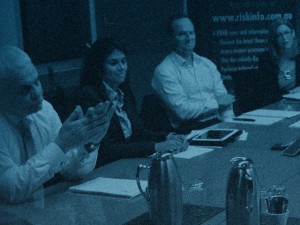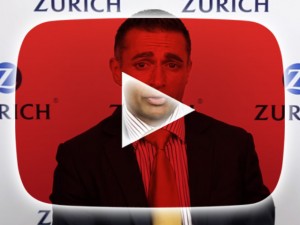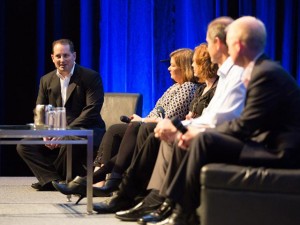In June this year, AIA Australia named Damien Mu as its new CEO, following the promotion of Peter Crewe to a senior executive role within AIA Group. Four months on, riskinfo spoke with Damien about his new role, and his outlook for the broader insurance industry…
Congratulations on the new role. You’ve been CEO for a few months, but have been working with the organisation for some time. What is it like to take on the ‘top job’?
I was really honoured to receive the call-up to lead the passionate people we have at AIA Australia. There is a culture here where we genuinely believe that we can make a difference; not just through life insurance, but by working together and believing we ‘can do’. I feel very fortunate to have the opportunity to continue to work with this great team.
We’re also very fortunate to have a lot of good support from our partners, our leadership group, the broader AIA Group and the Board.
I’m very excited by the prospect of where we can continue to go in the Australian market.
In your previous role, you were integral in launching AIA’s Vitality program. It is one of the most innovative initiatives to emerge in the Australian insurance market for some time – what drives a culture of innovation within AIA Australia?
The key to being innovative is having and embracing agility – being agile when it comes to the development of products and services, as well as the engagement of the consumer. If you hold back a product or service until you reach ‘nirvana’ you may actually miss the opportune time to launch; the market may have moved on.
We try to empower our product team to be confident enough to make and back their decisions. It’s really about looking at things differently, challenging ourselves to try different things, and then to and pick up on the learnings from each project, even if you don’t succeed.
The other element that drives innovation is thinking about the client. It’s not just about saying you have a client centric business, but actually applying that philosophy throughout the business, and that is something that we’ve been doing. We’ve been looking at how we can embed the client into our decision making process – not just through research, but also by testing and learning.
Do you think the wider Australian insurance industry does enough to promote/encourage innovation?
The market is definitely open to innovation, and I think there have been some positive developments over the past decade. For example, we’ve seen online applications for underwriting; the use of apps for quoting and for tracking the progress of cases. We’ve recently seen some movement towards electronic claims lodgement in super.
I think the challenge for us as an industry is around technology. How can we leverage technology and improve our digital capability so we can have a conversation with people who are having conversations in different ways? And that’s not just about having the digital capability, but matching that up with the right products and advice to support it.
We need to start looking at products that appeal to different segments of the market
Where do you see opportunities for the Australian insurance industry?
We need to start looking at products that appeal to different segments of the market, based on life stages, both in retail and in group. A good example is level premium products that are geared towards a life time decision. The question we need to ask ourselves is whether that is relevant today. Are clients thinking in 20 year blocks? Maybe we need to revisit our thinking around that and align pricing more to life stages.
Another would be to look at how we address some of the broader issues facing society. For example, when you think about issues like mental health or obesity or diabetes, the life insurance industry is in a unique position because we touch and talk to people about their health. While I don’t expect the life insurance industry to solve these issues on its own, we can work with others to form part of the value chain, to make a difference in those areas. The introduction of health and wellness coupled with life insurance creates an overall better value proposition for people to engage with as well.

Consumers took part in a range of activities at AIA Australia’s Vitality kiosks
Finally, we need to do more to improve the financial literacy of young Australians.
This was really highlighted for me as part of a program we undertook for AIA Vitality. We recently set up kiosks with some independent financial adviser partners in two metropolitan shopping centres to raise awareness of the program with prospective clients. As part of that project, shoppers were asked if they knew who their super fund was with, their life insurance provider and their health insurance provider. Roughly less than a third knew who their life insurer was, a bit less than half knew who their superannuation provider was, but nearly everyone knew who their health insurer was.
I think financial services businesses can champion the introduction of insurance and super topics into the high school curriculum. We can’t sit back and wait for things to happen – we need to take the lead. Whether it’s by getting involved directly in delivering literacy programs, or partnering with other organisations to get the message out in other ways.
What role does the government have to play in improving life insurance take-up, whether through financial literacy or other means, such as tax dis-incentives?
It’s incumbent on industry to tackle those issues. But I don’t think I’d be alone in saying it would help if there was more government advocacy for the importance of taking up private life insurance and creating a stronger link to policy. Life insurance can play a pivotal role in assisting both social and economic needs. We’ve seen how many people have taken out health insurance because of the incentives provided by government. It would definitely help if we had government support.
They are certainly aware of the issues and are listening to industry and trying to respond. But we could always do more, and that’s something that industry needs to take more responsibility for.
Bernie Ripoll talked about this at the AIA Australia Group Insurance Summit earlier this year, and he challenged the industry that if they have things they want the government to action, then perhaps we need to be lobbying more effectively with Canberra. That was quite insightful, I think.
the underinsurance issue is a different challenge than what it was five years ago
We’ve got to work through the various bodies, whether that be through the Financial Services Council or the Association of Superannuation Funds of Australia or others, to look at how we can come together to tackle industry-wide issues, knowing there is a benefit for all Australians if more people have appropriate life insurance.
If you could ‘wave your magic wand’, how would you solve Australia’s underinsurance problem?
It’s important to note that the underinsurance issue is a different challenge than what it was five years ago. Back then, when we were talking about underinsurance it was in relation to the fact that the majority of Australians had no cover. Now it’s about adequacy and the type of benefit that people have. So the challenge is a little bit different now. How do we help people to make that active decision to take up additional cover, to the level they actually need?
I don’t think there is a magic wand in that scenario. I think we’ve seen superannuation play a critical role in affording millions of people with cover, but to expect the superannuation industry to solve the current underinsurance problem would be unfair. They will play a role, but there are a couple of other factors that need to come into play.
First, we must start to educate at younger ages, because then people will become more aware, as they come out into the workforce, of the need to engage the appropriate help to make these decisions.
Then it’s about ensuring the products we’re developing are relevant to clients, so that they want to make the connection, and effectively communicating the benefits of life insurance so our clients can easily acquire it, whether that be digital or face to face. We need products and services that communicate with people in the way they want to be communicated with.
If we, as an industry, want to stay relevant, we will have to move down that path more quickly

Damien Mu is CEO of AIA Australia. He has more than 17 years’ experience in the Australian financial services industry, with management experience spanning operations, claims and underwriting, superannuation, investments, distribution, product, pricing and marketing.

















